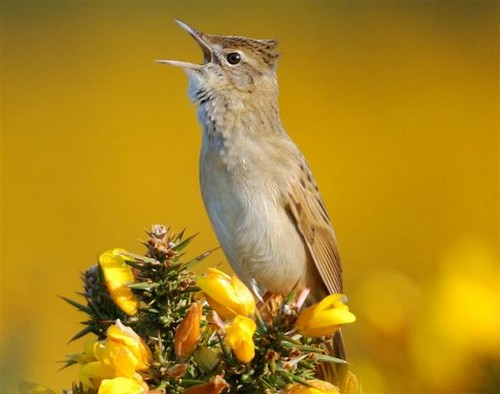Grasshopper Warbler
Reports

At this time of year the birdlife on Arran is enriched by the presence of a number of species of warbler, many of which have wintered far to the south. These include species like the Grasshopper Warbler. While not as a familiar as Willow Warbler, Chiffchaff and Blackcap, the Grasshopper Warbler is a welcome addition, but it may be being under-reported because it is difficult to detect despite its very distinctive call. Last year on Arran sixteen reports of Grasshopper Warbler were received compared to over three hundred reports of Willow Warbler.
The Grasshopper Warbler breeds across much of temperate Europe and western Asia. It is migratory, wintering in north and west Africa. India and Sri Lanka. The name Grasshopper Warbler refers to the characteristic insect-like song. There is an excellent example of the bird "reeling" on this website Grasshopper Warbler Reeling - YouTube https://www.youtube.com/watch?v=lZ9EIBKWyLA The song is an unmusical long, high-pitched reeling trill performed with beak held wide open and the whole body vibrating. It lasts for from a few seconds to two or three minutes with hardly a pause for breath. It varies in volume from a faint hum to a sound resembling a distant mowing machine. It is performed at any time of day from early morning until after the sun has set and is constantly to be heard from the arrival of the bird in spring until late July.
If it has such a distinctive song why could this species be being overlooked? There are a number of reasons.
First of all people do not recognise it as a bird sound. They think it is an insect. Secondly the birds skulk in the undergrowth. They like dense vegetation often close to water, rough grass and bushes such as the edges of fens, clearings, neglected hedgerows, heaths, upland moors, gorse-covered areas, young plantations and felled woodland. This bird seldom takes to the wing but spends its time scurrying through dense vegetation, flitting from twig to twig or running along the ground. It has a peculiar high-stepping gait and long stride as it moves along horizontal stems, looking slender and tapering. It seldom flies, soon diving back into cover, and when it alights it often raises and flares its tail. Another reason for the lack of detection is that the high pitch reel is not heard by people who, for various reasons including age, have lost the ability to hear high notes.
When you do see it, Grasshopper Warbler is a medium-sized warbler about 13 cm (5 in) long. The adult has a streaked brown back and whitish grey underparts which are unstreaked except on the undertail. The sexes are identical, as with most warblers, but young birds are yellower below.
The purpose of their reeling song is to attract a mate. When the pair gets together, both sexes take part in nest-building. The nest is well-concealed and built close to the ground in places like grass tussocks or dense scrub. It varies in size and shape but is constructed of grass, sedge and moss and often lined with fine grass. A clutch of four to six eggs is laid. Both parents are involved in incubating the eggs which take about fourteen days to hatch. The chicks are fed on insects. They fledge in twelve to thirteen days and there are usually two broods in the season. Young birds become mature at a year old and the highest recorded age for this species is five years.
Listen and look for this visitor when you are out and about this summer.